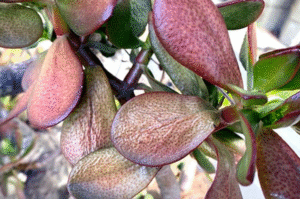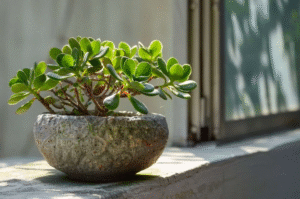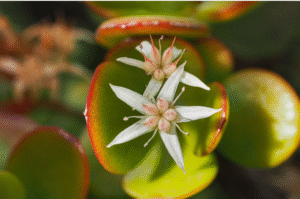Jade plants (Crassula ovata) are one of the most popular houseplants, loved for their fleshy green leaves and tree-like appearance. But despite their tough, succulent nature, many people make one major mistake (overwatering or underwatering).
If you want your jade plant to thrive for years, watering it the right way is key. In this complete guide, we’ll walk you through how to water a jade plant properly, what signs to watch out for, and helpful tips to keep your plant healthy and happy.
Why Watering Jade Plants Correctly Matters
Jade plants store water in their thick leaves and stems, which means they can survive long dry spells. However, that doesn’t mean they don’t need water at all. Too much water causes root rot, while too little leads to shriveling and slow growth.
Understanding your jade plant’s watering needs helps:
- Prevent yellowing or mushy leaves
- Avoid fungal infections
- Support strong root development
- Encourage vibrant, lush growth
How Often to Water a Jade Plant
The golden rule? Only water when the soil is completely dry.
Here’s a general watering frequency depending on the season:
| Season | Watering Frequency |
| Spring-Summer | Every 2–3 weeks (depending on humidity and pot size) |
| Fall-Winter | Once a month or less |
Always remember: It’s better to underwater than overwater a jade plant.
How to Check If Your Jade Plant Needs Water
Before reaching for the watering can, perform these simple checks:
- Touch the Soil
Stick your finger 1–2 inches deep into the soil. If it feels dry, it’s time to water. - Lift the Pot
If the pot feels light, the soil has dried out. A heavy pot means it still holds moisture. - Look at the Leaves
Wrinkled or droopy leaves? That’s a sign the plant is thirsty. Mushy or yellowing leaves? You’ve probably overwatered.
How to Water a Jade Plant: Step-by-Step
Watering a jade plant isn’t just about pouring water. Here’s a precise method to do it right:
Step 1: Use Room Temperature Water
Avoid cold water. Use filtered or rainwater if possible. Tap water with high minerals may build up over time.
Step 2: Water the Soil, Not the Leaves
Pour water directly into the soil around the base of the plant. Avoid getting the leaves wet—it can lead to fungal growth.
Step 3: Let Water Drain Completely
Always use a pot with drainage holes. Water the plant until it runs out of the bottom. Discard any excess water in the saucer.
Step 4: Don’t Water Again Until Dry
Wait for the soil to fully dry out before the next watering session. Never stick to a fixed calendar schedule.
Choosing the Right Pot and Soil for Water Control
Watering success isn’t just about how much water you give—it’s also about where the plant is living.
- Best Pot: Terra cotta or clay pots are ideal because they absorb moisture and allow the soil to dry faster.
- Drainage: Always use pots with drainage holes to avoid water pooling.
- Soil Mix: Use a cactus or succulent mix, or make your using:
- 2 parts potting soil
- 1 part perlite or pumice
- 1 part coarse sand
This mix ensures quick drainage and keeps roots healthy.
Common Jade Plant Watering Mistakes to Avoid
Even experienced plant lovers can make watering errors. Here are the top ones to watch out for:
Watering on a Schedule
Jade plants don’t like routine watering. Always check the soil first.
Letting the Plant Sit in Water
Never let the bottom of the pot sit in a saucer full of water.
Using Heavy, Moisture-Retaining Soil
Avoid standard potting soil unless mixed with perlite or sand.
Ignoring Seasonal Changes
In winter, jade plants go dormant. Watering during this time can lead to root rot.
Signs of Overwatered vs Underwatered Jade Plant
| Symptom | Cause | What to Do |
| Yellow, mushy leaves | Overwatering | Stop watering, repot in dry soil |
| Drooping, soft stems | Overwatering | Let soil dry, remove rotten roots |
| Wrinkled, shriveled leaves | Underwatering | Water deeply and wait for recovery |
| Leaf drop | Either | Check soil and adjust watering |
Bonus Tips for Watering Jade Plants
- Humidity: Keep jade plants in low-humidity areas. Bathrooms and kitchens are usually too humid.
- Watering Tool: Use a narrow-spout watering can to direct water to the soil.
- Light Affects Watering: More sunlight = more water evaporation. In bright locations, jade plants may need water more frequently.
Final Thoughts
Watering your jade plant may seem simple, but doing it correctly can make the difference between a healthy plant and one that slowly declines. Always check the soil, observe the plant, and adjust based on the environment. When in doubt, don’t water yet (your jade plant will thank you).
With the right watering habits, your jade plant can live for decades and become a stunning, tree-like centerpiece in your home.






